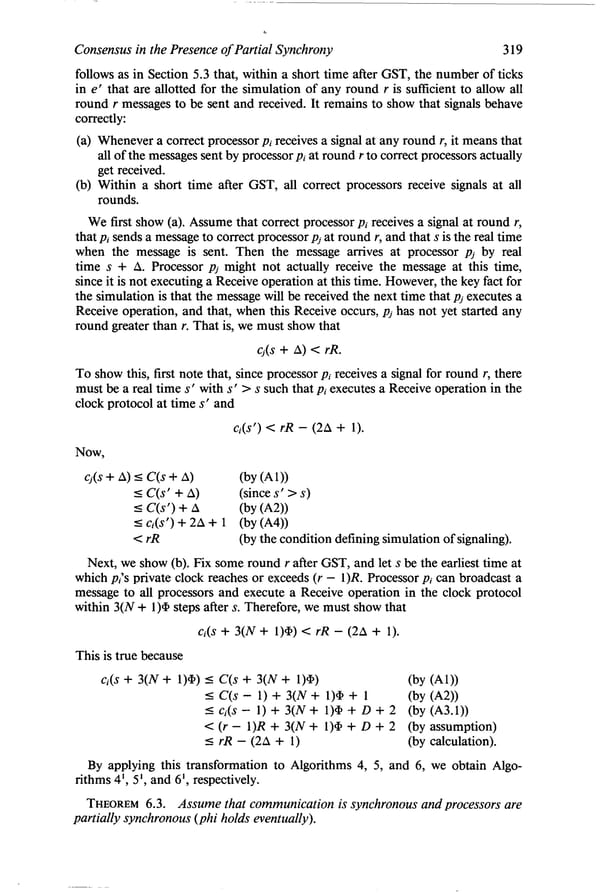Consensus in the Presence of Partial Synchrony 319 follows as in Section 5.3 that, within a short time after GST, the number of ticks in e’ that are allotted for the simulation of any round r is sufficient to allow all round r messages to be sent and received. It remains to show that signals behave correctly: (a) Whenever a correct processor pi receives a signal at any round r, it means that all of the messages sent by processor pi at round r to correct processors actually get received. (b) Within a short time after GST, all correct processors receive signals at all rounds. We first show (a). Assume that correct processor pi receives a signal at round r, that pi sends a message to correct processor pj at round r, and that s is the real time when the message is sent. Then the message arrives at processor pj by real time s + A. Processor pj might not actually receive the message at this time, since it is not executing a Receive operation at this time. However, the key fact for the simulation is that the message will be received the next time that pj executes a Receive operation, and that, when this Receive occurs, pj has not yet started any round greater than r. That is, we must show that Cj(S + A) < rR. To show this, first note that, since processor pi receives a signal for round r, there must be a real time s ’ with s ’ > s such that pi executes a Receive operation in the clock protocol at time s’ and Ci(S’) < rR - (2A + 1). Now, Cj(S + A) = C(S + A) (by (Al)) sC(s’+A) (since s’ > s) s C(s’) + A (by 042)) s Ci(S’) + 2A + 1 (by (A4)) < rR (by the condition defining simulation of signaling). Next, we show (b). Fix some round r after GST, and let s be the earliest time at which p;s private clock reaches or exceeds (r - 1)R. Processor pi can broadcast a message to all processors and execute a Receive operation in the clock protocol within 3(N + I)@ steps after s. Therefore, we must show that Ci(S + 3(N + l)@) C rR - (2A + 1). This is true because Ci(S + 3(N + I)@) 5 C(S + 3(N + l)@) (by (Al)) 5 C(s - 1) + 3(N + l)@ + 1 (by b42N 5 Ci(S - 1) + 3(N + l)@ + D + 2 (by (A3.1)) < (r - 1)R + 3(N + l)@ + D + 2 (by assumption) 5rR-(2A+ 1) (by calculation). By applying this transformation to Algorithms 4, 5, and 6, we obtain Algo- rithms 4’, 5’, and 6’, respectively. THEOREM 6.3. Assume that communication is synchronous and processors are partially synchronous (phi holds eventually).
 Consensus in the Presence of Partial Synchrony Page 31 Page 33
Consensus in the Presence of Partial Synchrony Page 31 Page 33